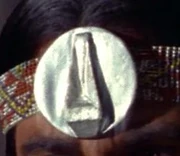
Obelisk on Amerind

Burnham sees an obelisk

Interior of the Amerind obelisk
A Preservers' obelisk was a marker left by a super-race known as the Preservers. Obelisks existed on Amerind and one of the moons of Andoria. (DIS: "Context Is for Kings"; TOS: "The Paradise Syndrome")
Structure and operation[]
The external structure consisted of two parts, a base and a larger metallic fixture. The latter was one big deflector structure. Constructed of an alloy resistant to probe, the marker resisted analysis. Its surface was partially covered in a highly advanced form of cipher writing, which were musical notes.
A sliding trapdoor at the base gave access to a cavern-like room full of scientific equipment and more writing. The structure was controlled from a deflector panel similar to those Spock was familiar with, but far more complicated.

Medicine badge depicting the obelisk
It was said that after the Wise Ones transported the group, they chose a medicine chief to keep the secret of the temple. He was trained to use the temple for its stated purpose, asteroid deflection. The secret of how to operate the obelisk was passed on from father to son, and the hidden room also contained a memory beam for further instruction. Operation involved the activating of relays in sequence. The medicine chief carried a medicine badge on his head which resembled the obelisk. (TOS: "The Paradise Syndrome")
History[]
In 2256, Michael Burnham saw a Preserver obelisk while first experiencing the effects of the USS Discovery spore drive. (DIS: "Context Is for Kings")
The age of the Amerind obelisk could not be determined. However, by 2268 it was malfunctioning. A group of Humans lived near the Obelisk, and considered it to be a temple in which there lived a spirit. Their priestess offered foods to the obelisk.
In 2268, a landing party from the USS Enterprise explored the Amerind and found the obelisk. During the mission, Captain Kirk inadvertently hit on the tonal combination that opened the access hatch atop the base. As he was standing on the hatch at the time, this pitched him down the stairs into the base. Stunned, he attempted to regain his footing but succeeded only in incorrectly triggering a memory beam designed to instruct a user in the operation of the machinery contained within the obelisk – a powerful asteroid deflector. This robbed him of his memory. Because no other member of the landing party saw this accident or could discover their captain's whereabouts, they were forced to leave him on Amerind for several months while the Enterprise attempted to divert an asteroid on a collision course with Amerind.
Spock eventually discovered how to interpret the alien language, and learned the purpose of the structure. Returning to Amerind, he was able to restore Kirk's memories and between them, they discovered how to operate the deflector and save the people of Amerind. During his stay there, Kirk learned that the Preservers, whom the natives called "Wise Ones", left the secret of operating the deflector with one member of the tribe, the medicine chief. In 2268, a man named Salish held that office. Salish's father did not wish to share his knowledge too soon, ultimately dying before he did, so Salish could not save his people.
The deflector mechanism was considerably more powerful than the deflection beams the Enterprise could generate with full engine power. It easily pushed the asteroid away with just a few seconds of contact. (TOS: "The Paradise Syndrome")
While Spock concluded that the preserver obelisk had become defective, he later operated it without the need for repairs. The real reason it failed to operate presumably lies in something Miramanee mentioned earlier in the episode: it had to be actively operated by the medicine chief, according to secret knowledge passed from father to son, but the current medicine chief had not received this secret from his father.
The obelisk was designed by Matt Jefferies and constructed out of plexiglass. While it is referred to as an "obelisk", its shape does not really fit the definition of one since it is not very tall, doesn't have flat sides that taper off, and does not have a pyramidal top.
